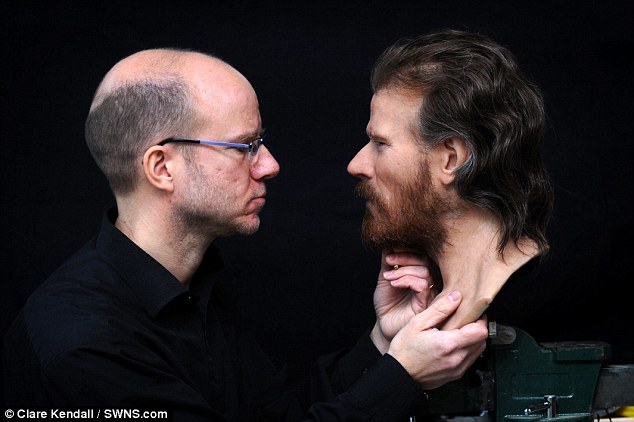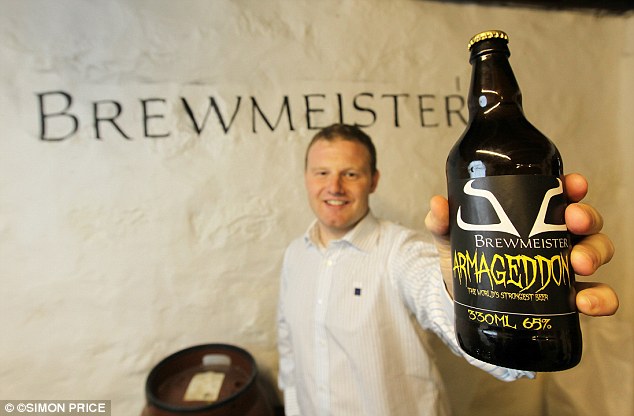Visitors can come face to face with a real Neolithic Briton when the new £27 million Stonehenge visitor centre opens tomorrow.
The man's face is based on a 5,500 year old skull that was excavated from a long barrow not far from Stonehenge in 1963. It is the most advanced facial reconstruction of a Neolithic person ever undertaken.
There is also a 360-degree Stand in the Stones experience, using state-of-the-art laser scans, to allow visitors to experience summer and winter solstices inside the ancient monument.
Two rare 14th century manuscripts, including some of the earliest drawings of the monument, Roman coins and jewellery are also on display.
Modern facilities for the centre's visitors - 65% from overseas - include a 'bright, spacious' cafe and shop.
In the shop, tourists can pick up souvenirs such as a £7.99 mouse-mat, £11.99 baseball cap, £300 silver bracelet or £9.99 Christmas bauble with a festive scene of Stonehenge painted on it.
Visitors can also attempt to pull a large sarsen stone on rollers outside the visitor centre.
The visitor centre is 1.5 miles away from Stonehenge and is deliberately placed behind a group of trees so that it cannot be seen from the ancient monument.
The facilities are housed in a pair of single-storey 'pods', sitting beneath an undulating canopy that mimics the rolling plains nearby.
To improve the experience of visiting the world's most famous prehistoric monument, the section of the A344 road nearby (which runs from Hampshire, through Wiltshire, past Stonehenge, and into Somerset) has been permanently closed.
The face of prehistoric Britain: Forensic scientist uses Neolithic man's 5,500-year-old skull to create lifelike image
£27 million project, led by English Heritage, began last year
Includes most advanced reconstruction of an early Neolithic man's face
Skeleton was found buried in a long barrow 1.5 miles from Stonehenge
A344 road, which runs past Stonehenge, was permanently closed in June
By Emma Thomas
17 December 2013
Daily Mail
Daily Mail
He is the star attraction of Stonehenge's new £27million modern visitor centre that has taken decades to produce.
A Neolithic man has been brought to life after the most advanced forensic reconstruction of a face, based on a 5,500-year-old skeleton buried in a long barrow 1.5 miles from Stonehenge.
More than a million people flock to the popular ancient monument in Wiltshire each year, with hundreds attending ceremonies to mark the solstices.
Since the end of the 19th century, Stonehenge has been 'severely compromised' by the intrusion of roads and traffic, with 'outdated and inadequate' visitor facilities.

Forensic artist Oscar Nilsson's reconstructed head of an adult male based on a skeleton which was excavated in 1863 from a long barrow


Stonehenge's connection to the surrounding prehistoric landscape and nearby ancient monuments has also been cut off with roads and fences.
Work to 'restore the dignity' of the monument as part of a £27 million project led by English Heritage began last year.
A section of the A344 road, which runs past Stonehenge, was permanently closed in June and the visitor building - complete with a 'thrilling' exhibition - will now open.
The centre, designed by architects Denton Corker Marshall, lies a mile-and-a-half to the west of the stones.

Forensic artist Oscar Nilsson works on the reconstructed head based on a skeleton which was excavated in 1863 from a long barrow at Winterbourne Stoke, Wiltshire

Reconstruction: Forensic artist Oscar Nilsson works on the reconstructed head of an adult male based on a skeleton which was excavated in 1863 from a long barrow at Winterbourne Stoke, Wiltshire, near the stones
Stonehenge is not immediately visible from the visitor centre, with tourists able to use a 10-minute shuttle bus or walk down a newly-reconnected ancient processional approach.
Further work to decommission the existing facilities, built in 1968, and returning the car park to grass will commence in January.
The transformation is the largest capital project ever undertaken by English Heritage.
Simon Thurley, chief executive of English Heritage, said: 'This is the end of an incredibly long journey.

Artifacts: A curator handles the jaw bone of a domestic cow at the new English Heritage Stonehenge exhibition

A skeleton inside the new Stonehenge visitor centre. There are 250 prehistoric objects - many unseen before - on loan from various collections that will be available to view at the £27million building in Wiltshire
'Stonehenge is almost certainly the most famous ancient monument in the world and up until now it hasn't really had adequate visitor facilities.
'There's been no exhibition, no opportunities for people to have a cup of tea, even.
'There's been no exhibition, no opportunities for people to have a cup of tea, even.
'This is a radical change for the million people a year who come to Stonehenge.
'They can see the stones for the first time free from the clutter and rubbish that have accrued around them since the 1960s.
'They can understand them properly because we have an exhibition here that can take people back into the Neolithic period.

Virtual: Rory, 11, and Flora 7, watch the new virtual experience inside the Stonehenge visitor centre

Open: English Heritage will be unveiling the new multi-million pound visitor centre at Stonehenge. It is located about a mile and a half from the stones and will open to the public on Wednesday, December 18
'We now have something that I think is worthy of one of the world's greatest archaeological sites.'
Dr Thurley added: 'In 1927 it was announced that the A344 would be closed. That was 85 years ago.
'By the 1960s there was a view that there should be a bit more for visitors and the first scheme was proposed.
'The first objectors started objecting and that has been the story for almost 55 years.'
The exhibition will be the first to explain Stonehenge to visitors, with 250 prehistoric objects - many unseen before - on loan from various collections.
One highlight is the most advanced forensic reconstruction of an early Neolithic man's face, based on a 5,500-year-old skeleton buried in a long barrow 1.5 miles from Stonehenge.

Visitor centre: A £27million project to modernise facilities at Stonehenge will finally be opened tomorrow

Stones: More than a million people flock to the popular ancient monument in Wiltshire each year
There is a 360-degree Stand in the Stones experience, using state-of-the-art laser scans, to allow visitors to experience summer and winter solstices.
Two rare 14th century manuscripts, including some of the earliest drawings of the monument, Roman coins and jewellery are also on display.
Modern facilities for the centre's visitors - 65% from overseas - include a 'bright, spacious' cafe and shop.
In the shop, tourists can pick up souvenirs such as a £7.99 mouse-mat, £11.99 baseball cap, £300 silver bracelet or £9.99 Christmas bauble with a festive scene of Stonehenge painted on it.
The facilities are housed in a pair of single-storey 'pods', sitting beneath an undulating canopy that mimics the rolling plains nearby.
Architect Steve Quinlan, of Denton Corker Marshall, said: 'The monument is a place for quiet contemplation but everyone coming here zips down the A303, in a 21st century way.

Design: The facilities are housed in a pair of single-storey 'pods', sitting beneath an undulating canopy that mimics the rolling plains nearby. It was designed by architect Steve Quinlan of Denton Corker Marshall

Road: Part of the A344 road which passed close to the landmark has been grassed over. The centre, designed by architects Denton Corker Marshall, lies a mile-and-a-half to the west of the stones and includes a cafe
'We are trying to take someone from that world through to the world of the monument.
'That's a big trip.'
Mr Quinlan said the centre had been designed with a deliberate walk between it and a new car park for 500 vehicles and 30 coaches to move people gradually towards Stonehenge.
Materials for the project have all been sourced within 50 miles.
The landscape around the stones has also been improved, with the road running right past the Heel Stone closed and reseeded with grass and tall fences removed.
The Avenue, Stonehenge's ancient processional approach is now reconnected to the monument.
Culture Secretary Maria Miller said: 'Stonehenge is one of the UK's most iconic sites, undeniably worthy of its Unesco world heritage status, attracting one million tourists every year from the UK and all over the world.

Bus: Stonehenge is not immediately visible from the visitor centre, with tourists able to use a 10-minute shuttle bus or walk down a newly-reconnected ancient processional approach, with landscaping, to the historic site

New facility: The long-awaited Stonehenge exhibition and visitor centre will open on 18 December
'So it's only right that, after decades of indecision, we can now offer them a visitor exhibition centre and experience they deserve.
'A huge amount of work has gone into getting this right and making sure people can see the stones and their story in a whole new light.'
Stonehenge was formally recognised as a monument of national importance in 1883 and protected by the newly-introduced Ancient Monuments Act.
Visitors originally approached Stonehenge over unmapped and unfenced sheep pastures but by the mid-19th century, most began arriving on the A344 road.
At the end of the century, people were complaining of the number of wagons, horses and unruly crowds at the monument.

Path: The transformation is the largest capital project ever undertaken by English Heritage funded by donations

Interactive: Young visitors to the World Heritage Site of Stonehenge near Salisbury in Wiltshire attempt to pull a sarsen stone outside the new visitor centre. English Heritage took on the site in 1984, when it was established
In 1915, it was sold at auction to local Cecil Chubb for £6,600. He presented it to the nation three years later.
A free car park was installed in 1935 and in 1968 facilities including a pedestrian underpass were opened.
English Heritage took on guardianship of the site in 1984, when it was established.
Two years later, in 1986, Stonehenge, along with Avebury Henge and the Stone Circles, was inscribed on the world heritage list.
At this time, the UK government pledged to remove the A344 by Stonehenge, which had become the main access route. It was used by 6,000 vehicles daily.
The project has been funded by Heritage Lottery Fund money, English Heritage's commercial income and philanthropic donations.
Loraine Knowles, Stonehenge director for English Heritage, said: 'This is a major milestone in a long journey to make the experience of Stonehenge worthy of its iconic world heritage status.'
Last edited:





